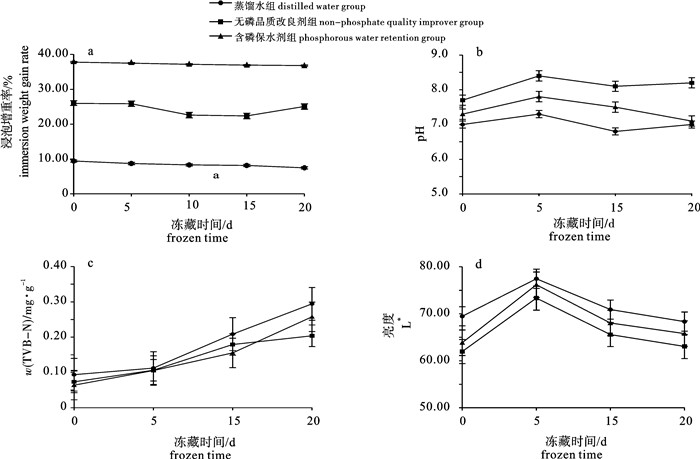Effects of non-phosphate quality improver on the frozen denaturation of Argentine squid
-
摘要:
通过考察阿根廷鱿鱼(Sepiaiuex argentinus)在冻藏过程的浸泡增重率、自由液滴损失率、蒸煮损失率、盐溶性蛋白、肌原纤维蛋白钙ATP酶(Ca2+-ATP酶)活性、pH、总挥发性盐基氮(TVB-N)以及色泽的变化,试验分别比较了蒸馏水、常用的含磷保水剂及无磷品质改良剂对阿根廷鱿鱼冷冻质量的影响。结果表明,鱿鱼经无磷品质改良剂或含磷保水剂处理后,在冻藏过程中较用蒸馏水处理的具有更好的保水性,浸泡增重率达到26%~35%,但无磷品质改良剂较含磷保水剂能更好地减少鱿鱼自由液滴损失率和蒸煮损失率,且盐溶性蛋白减少率和Ca2+-ATP酶活性损失率分别比含磷保水剂组少6%和5%,TVB-N变化缓慢且小于0.30 mg·g-1,而对鱿鱼pH和色差值影响不大。因此,无磷品质改良剂能有效防止冻藏鱿鱼冷冻变性,且效果优于含磷保水剂,值得在鱿鱼冷冻加工中推广应用。
Abstract:We compared the effects of distilled water, phosphorous water retention agent and non-phosphate quality improver on the frozen quality of Argentina squid (Sepiaiuex argentinus) during the frozen storage in terms of immersion weight gain rate, free drip loss rate, pH, salt-soluble protein value, Ca2+-ATPase activity, TVB-N value and L* value. The results show that the weight gain rate of Argentina squid that treated with non-phosphate quality improver maintain well, achieving 26% to 35%, which equals to phosphorous group. However, non-phosphate quality improver can better reduce the free drip loss and cooking loss rate. Besides, in fish treated with non-phosphate quality improver, the decrement rate of squid salt-soluble protein and Ca2+-ATPase activity are respectively 6% and 5% lower than in the phosphorous group; and TVB-N values change slower, which are less than 0.30 mg·g-1. There are few effects on the squid pH and L* values. The non-phosphate quality improver could protect the protein freeze denaturation, and functions better than phosphorous aquasorb during the frozen storage, thus is worthy of popularization and application in squid frozen processing.
-
阿根廷鱿鱼(Sepiaiuex argentinus),学名为枪乌贼,是软体动物门、头足纲、鞘亚纲、柔鱼科和枪形目软体动物的俗称[1]。鱿鱼富含人体必需的多种氨基酸,还含有丰富的牛磺酸、章肉碱、嘌呤、核苷酸类等风味物质,是一种营养保健型且风味良好的水产品资源[2]。
目前,鱿鱼产品品种单一,加工品少,广泛使用的储藏方法是低温冷冻保藏,由于阿根廷鱿鱼受冻藏温度的影响较大,鱼肉蛋白易发生冷冻变性,导致鱼肉的柔嫩性、持水性、胶凝性及营养价值等均会发生劣变。研究发现,有效防止蛋白质变性最可行的方法是加入保水剂。目前多聚磷酸盐是水产品加工中应用较为广泛的保水剂,然而生产上过量使用会产生不良效应,人体长期过量摄入会影响机体的钙磷平衡[3]。因此,为了改善阿根廷鱿鱼在冷冻加工中的品质,提高鱿鱼加工产品质量安全,笔者试验探讨了以海藻糖、碳酸钠、抗坏血酸钠、变性淀粉组成的无磷品质改良剂对不同冻藏温度的阿根廷鱿鱼抗冷冻变性的影响,以期开发安全、无毒、高效的无磷品质改良剂,为替代鱿鱼加工过程中含磷保水剂的使用提供技术依据。
1. 材料与方法
1.1 主要原料与试剂
阿根廷鱿鱼由汕头正林食品有限公司提供。试剂有海藻糖(纯度≥99%)(南宁中诺生物工程有限责任公司出品);碳酸钠(分析纯,AR)(广州化学试剂厂出品);抗坏血酸钠(AR)(广州齐云生物技术有限公司出品);变性淀粉(广州化学试剂厂出品);含磷保水剂(汕头正林食品有限公司出品);超微量ATPase测试盒(南京建成科技有限公司出品);蛋白定量测试盒(南京建成科技有限公司出品);其他未说明试剂均为分析纯试剂。
1.2 主要仪器设备
Sigma-3K30高速冷冻冷冻离心机(美国Sigma公司出品);KjeltecTM2300型凯式定氮仪(丹麦产);Ultra Turrax T25B型均质机(德国IKA工业设备公司出品);GENESYS5型紫外分光光度计(美国Spectronic科技公司出品);PB-10型精密pH计(德国Sartorius公司出品);SC-80C型全自动测色色差计(北京康光光学仪器有限公司出品);其他均为实验室常用仪器。
1.3 方法
1.3.1 阿根廷鱿鱼处理流程
阿根廷鱿鱼→清洗→去皮→分割→浸渍液处理→沥干→冻藏。
1.3.2 浸渍液处理设计
经前处理的鱿鱼分别用不同浸渍液处理,浸渍液为:1)浸渍液A是蒸馏水,为空白对照组;2)浸渍液B由笔者实验室开发的以海藻糖、碳酸钠、抗坏血酸钠、变性淀粉组成的无磷品质改良剂,为试验组;3)浸渍液C含磷保水剂,为条件对照组。
1.3.3 鱿鱼肉品质指标检测[4-9]
1) 自由液滴损失率的测定。将鱿鱼段称质量后,立即放入铺有滤纸的培养皿内,加盖后放入35 ℃恒温箱中,1.5 h后取出,用滤纸轻轻拭去鱼片表面的液体后称质量。每个浸渍液都设3个平行,取平均值。自由液滴损失(%)=(减少的质量/原有质量)×100。
2) 蒸煮损失率的测定。取鱿鱼段,称质量,放入小烧杯中,盖紧盖子后用沸水蒸10 min,放凉,用滤纸吸掉表面水分,称质量。每个浸渍液都设3个平行,取平均值。蒸煮损失率(%)=[(蒸煮前质量-蒸煮后质量)/蒸煮前质量]×100。
3) 浸泡增重率的测定。准确称质量样品,记录质量并编号,分别放入3种不同浸渍液(始终保持其温度为0 ℃)中浸渍12 h,间隔1 h缓慢搅拌,12 h后取出沥干,10 min后准确称质量。每个浸渍液都设3个平行,取平均值。浸泡增重率(%)=[(浸泡后质量-原有质量)/样品原质量]×100。
4) pH的测定。取5.0 g鱿鱼段加入45 mL蒸馏水进行匀浆,静置30 min,离心后取上清液,用pH计测定。
5) 总挥发性盐基氮(TVB-N)的测定。将冷冻的鱿鱼段切碎,称取碎肉5 g于均质杯中,加入45 mL 0.6 mol·L-1的高氯酸溶液,均质,用滤纸过滤或离心分离,然后用全自动凯式定氮仪测定样品中的TVB-N质量分数。
6) 色差的测定。室温下用全自动测色色差计测定样品的表面亮度,仪器采用标准白板校正。
7) 盐溶性蛋白的测定。将冷冻的鱿鱼段切碎,称取碎肉4 g,用质量体积比加生理盐水制备成10%的组织匀浆,3 000 r·min-1,离心10 min后取组织匀浆上清,再用生理盐水按1:9稀释成1%的组织匀浆,用考马斯亮蓝法测定组织蛋白。
8) 肌原纤维蛋白钙ATPase(Ca2+-ATP酶)活性的测定。采用ATPase检测试剂盒测定。规定1个ATPase活力单位是每小时每毫克组织蛋白的组织中ATPase分解ADP产生1 μmol无机磷的量。
1.3.4 数据统计方法
试验数据均为3次平行试验的平均值,经Excel 2007初步整理后,采用SPSS 19.0进行统计分析,试验结果用平均数±标准差(X±SD)表示,P<0.05表示差异显著。
2. 结果与分析
2.1 不同浸渍液对自由液滴损失率的影响
冻藏过程中鱿鱼肉内部的水结晶,造成细胞膜渗透压改变及细胞破裂,解冻后冰晶融化,水分流出,造成自由液滴损失。自由液滴损失率越低,意味着鱿鱼肉持水能力越高,即产品的出产率也相对提高[9]。经不同浸渍液处理的鱿鱼冻藏后都会产生较大的自由液滴损失,其中蒸馏水浸泡组,在第5天自由液滴损失率就达8.15%,到第20天为12.47%,损失率达4.32%;含磷保水剂组,在第5天自由液滴损失率仅为4.25%,到第20天为7.38%,损失率达3.13%;而无磷品质改良剂组,在第5天自由液滴损失率为7.75%,到第20天为8.13%,随着冻藏时间的延长,损失率略有增加,损失率达0.38%,分别比含磷组和蒸馏水组降低了2.75%和3.94%(表 1)。说明含磷保水剂在冻藏初期自由液滴损失较少,但随着冻藏时间延长,鱿鱼肉中冰晶增大明显,造成解冻之后细胞破裂增多,造成液滴损失增多。而无磷品质改良剂能有效地防止鱿鱼肉组织中大冰晶的形成,从而使得产品解冻过程细胞受损不严重,防止了液滴的损失。由此可见,无磷品质改良剂对鱿鱼在冻藏过程的保水能力更好,较稳定。
表 1 不同浸渍液处理对冻藏鱿鱼自由液滴损失率和蒸煮损失率的影响Table 1 Effects of different maceration extract treatments on free drip loss rate and cooking loss rate of frozen squid% 处理
treatment group自由液滴损失率
free drip loss rate蒸煮损失率
cooking loss rate5 d 20 d 5 d 20 d 蒸馏水组 distilled water group 8.15±1.46 12.47±5.56 45.39±4.61 48.65±3.60 无磷品质改良组 non-phosphate quality improver group 7.75±0.06 8.13±1.17 30.73±3.77 35.10±0.63 含磷保水剂组 phosphorous water retention agent group 4.25±1.00 7.38±0.69 40.32±2.44 43.35±4.23 2.2 不同浸渍液对蒸煮损失率的影响
经不同浸渍液处理的鱿鱼冻藏后都会产生较大的水分蒸煮损失,其中蒸馏水浸泡组在第5天蒸煮损失率达45.39%,到第20天达48.65%;无磷品质改良剂组在第5天蒸煮损失率为30.73%,到第20天为35.10%;而含磷保水剂在第5天蒸煮损失率达40.32%,到第20天达43.35%,其中蒸馏水浸泡组经过冻藏过程,蒸煮之后水分流失接近50%,而含磷保水剂组在蒸煮后水分也流失了43%,无磷品质改良剂组在蒸煮后水分流失率仅为35.10%,分别比含磷组和蒸馏水组降低了约8%和15%(表 1)。说明无磷品质改良剂对鱿鱼在冻藏过程的保水功能最好,从而能够保持鱿鱼具有较好的品质。
2.3 不同浸渍液对浸泡增重率的影响
无磷品质改良剂能渗透到鱼肌肉中与蛋白质相互作用,增大了肌束之间和肌原纤维之间的空间,使得大量的水分被吸附[10]。经过浸泡后的鱿鱼质量都相应增加,样品浸泡增重率都存在显著差异(P<0.05),含磷保水剂组的增重效果最好(35%);其次为无磷品质改良剂组(26%)(图 1-a);蒸馏水浸泡的增重效果最差(9%)。冻藏20 d后无磷品质改良剂组和含磷保水剂组仍能保持较好的增重率。无磷品质改良组在第20天浸泡增重率反而升高,可能是由于鱼肉蛋白发生部分变性反应导致的。
2.4 不同浸渍液对pH的影响
pH可以作为鲜度变化的一项重要参考指标。随着鱼鲜度的劣变,pH明显降低[11]。蛋白质所带静电荷的数量,决定着肌肉的保水能力,而静电荷量与肌肉pH密切相关。3组样品的变化趋势基本一致,均随冻藏时间延长,总体呈先上升再下降趋势,说明冻藏过程中,鱼肉蛋白质不断降解,pH由偏碱性变为中性,但pH始终维持在6.0~8.0,说明不同浸渍液对冻藏样品的pH影响不明显(图 1-b)。
2.5 不同浸渍液对TVB-N的影响
根据GB 2733-2005《鲜冻动物性水产品卫生标准》中规定,鱿鱼的w(TVB-N)≤0.30 mg·g-1[12]。鱿鱼在冻藏期间w(TVB-N)一致呈上升趋势,但均小于0.30 mg·g-1,符合国家标准要求(图 1-c)。但仅用蒸馏水处理组的样品,w(TVB-N)上升最快,无磷组和含磷保水剂处理的样品w(TVB-N)变化较缓慢(P<0.05)。无磷品质改良剂能有效改善冻藏鱿鱼的品质。
2.6 不同浸渍液对L*的影响
L*又称亮度,各色混合的非彩色,这些非彩色由暗到明表现为黑色-灰色-白色,L*越大颜色越亮。解冻后的鱿鱼颜色略发白,颜色较为一致,故选定L*来进行其色泽的评价[13]。3组样品均在冻藏初期L*较大,色泽较亮,但随着冻藏时间的延长,L*缓慢降低,3个处理组样品的L*变化差异不显著(P>0.05)(图 1-d)。说明浸渍液处理对鱿鱼的色泽影响不明显。
2.7 不同浸渍液对盐溶性蛋白的影响
盐溶性蛋白是一类具有重要生物学功能的结构蛋白质群,与肉制品的保水性密切相关[8]。在冻藏过程中,肌原纤维蛋白分子之间由于氢键、疏水键、二硫键的形成二聚集变性,故其盐溶性下降。盐溶性蛋白质量浓度高,在一定程度上可以表明其保水性好。鱿鱼在-18 ℃冻藏20 d后,蒸馏水组、无磷品质改良剂组和含磷保水剂组的盐溶性蛋白质量浓度依次为112 μg·mL-1,310 μg·mL-1和182 μg·mL-1,较首日分别降低了80%、64%和70%;其中经品质改良剂组处理后的盐溶蛋白质量浓度分别比含磷组和蒸馏水组高70.3%和176%(图 2-a)。所有样品的盐溶性蛋白整体上随着冻藏时间的增加不断下降,以蒸馏水组的盐溶性蛋白质量浓度最低及下降程度最大,其次是含磷保水剂组,说明蒸馏水组样品在冻藏过程中发生了严重的变性,时间越长,变性越严重;含磷保水剂组虽然能在一定程度上抑制肌原纤维蛋白的冷冻变性,但效果不如无磷品质改良剂,无磷品质改良剂的添加能有效降低鱼片在冻藏过程中的盐溶性蛋白损失,对蛋白质具有冷冻保护作用。
2.8 不同浸渍液对Ca2+-ATP酶活性的影响
肌原纤维蛋白质的空间结构有利于锁住肌肉水分,冻藏过程中肌球蛋白的变性,会导致其Ca2+-ATP酶活性的下降,所以肌球蛋白的冻藏稳定性对整个肌原纤维蛋白的冻藏稳定性有着重要的影响[14]。长时间的冷冻破坏了蛋白质分子与结合水的结合状态,导致蛋白质变性,使鱼肌原纤维蛋白Ca2+-ATP酶活性下降,因此肌原纤维蛋白的ATP酶活性被广泛用作鱼肉蛋白变性指标[15-16]。随着冻藏时间增加,各种处理的鱿鱼Ca2+-ATP酶活性均显著降低(P<0.05),说明在冻藏过程中均发生了冷冻变性(图 2-b)。其中蒸馏水组Ca2+-ATP酶活性下降的趋势最快,其次是含磷保水剂组。无磷品质改良剂组的Ca2+-ATP酶活性虽然不是最高的,-18 ℃冻藏的样品初始活性为1.028 U·mg-1,冻藏20 d后活性为0.411 U·mg-1,降低了60%。蒸馏水组样品的Ca2+-ATP酶在-18 ℃冻藏初始活性为2.215 U·mg-1,冻藏20 d后活性为0.739 U·mg-1,降低了67%;含磷保水剂组Ca2+-ATP酶活性由1.637 U·mg-1降至0.572 U·mg-1,降低了65%。其中经无磷品质改良剂组处理后的Ca2+-ATP酶活性损失率最小,分别比含磷保水剂组和蒸馏水组少5%和7%。Ca2+-ATP酶活性下降的原因目前有以下几种[17]:1)由于冰晶的机械作用引起的;2)由pH下降引起的;3)由于巯基氧化形成二硫键导致分子聚合引起的。无磷品质改良剂的添加能有效地保护蛋白质分子的自然结构,从而延长样品保质期。无磷品质改良剂中的海藻糖成分能够稳定细胞膜结构,具有抗逆保鲜作用和抗冷冻保护作用。说明无磷品质改良剂能很好地防止鱿鱼肌原纤维蛋白发生冷冻变性。
3. 讨论
3.1 品质改良剂抑制冻藏鱿鱼冷冻变性机理探讨
含磷保水剂主要由复合磷酸盐组成,是冷冻水产品常用的添加剂。复合磷酸盐缓慢释放磷酸根离子,增加肌动球蛋白的亲水性,以稳定鱼肉蛋白;可与某些金属离子络合,以提高鱼肉蛋白的持水性;还可与水分子作用形成氢键,提高了蛋白质的凝胶保水性[6, 18]。但在生产上过量使用会产生不良效应。海藻糖为非还原性二糖,具有保护生物细胞和活性物质的功能,并耐受干旱、高温、冷冻等环境。海藻糖能有效地保护蛋白质分子的自然结构,具有稳定细胞膜、抗逆保鲜作用和抗冷冻保护作用,从而延长保质期[19]。海藻糖作为保水剂,其保水性机理有“水替代说”和“玻璃态学说”2种假说。“水替代说”认为海藻糖分子结构含有大量的羟基,能与水分子作用形成氢键,从而提高了水分子的稳定性[20]。而“玻璃态学说”解释为海藻糖发生玻璃态转变形成新的无定形连续相,阻碍了水分子运动,从而提升水分稳定性[21]。抗坏血酸钠是一种常用于水产品、肉制品等深加工食品的抗氧化剂,具有护色作用[22]。变性淀粉是食品加工中一种常用的食品添加剂,具有改善食品质构,提高食品增稠性和保水性,延长食品保质期等功能[23-24]。
3.2 无磷改良剂在冻藏鱿鱼中的应用
通过比较空白、常用的含磷保水剂、无磷品质改良剂处理阿根廷鱿鱼,考察其在冻藏过程的水分流失、盐溶性蛋白、肌原纤维蛋白Ca2+-ATP酶活性、pH、TVB-N和色泽变化,结果表明,实验室根据GB 2760-2011食品安全国家标准——食品添加剂使用标准,开发的由海藻糖、碳酸钠、抗坏血酸钠、变性淀粉组成的无磷品质改良剂对肌原纤维蛋白质的冷冻变性有较好的抑制作用,保水效果好,对鱿鱼的品质维护较好,是一种值得在鱿鱼冷冻加工中推广应用的无磷品质改良添加剂。
-
表 1 不同浸渍液处理对冻藏鱿鱼自由液滴损失率和蒸煮损失率的影响
Table 1 Effects of different maceration extract treatments on free drip loss rate and cooking loss rate of frozen squid
% 处理
treatment group自由液滴损失率
free drip loss rate蒸煮损失率
cooking loss rate5 d 20 d 5 d 20 d 蒸馏水组 distilled water group 8.15±1.46 12.47±5.56 45.39±4.61 48.65±3.60 无磷品质改良组 non-phosphate quality improver group 7.75±0.06 8.13±1.17 30.73±3.77 35.10±0.63 含磷保水剂组 phosphorous water retention agent group 4.25±1.00 7.38±0.69 40.32±2.44 43.35±4.23 -
[1] 周金官, 陈新军, 刘必林. 世界头足类资源开发利用现状及其潜力[J]. 海洋渔业, 2008, 30(3): 268-275. doi: 10.3969/j.issn.1004-2490.2008.03.013 [2] 陈意. 鱿鱼的营养及食用价值[J]. 食品与药品, 2006, 8(6): 75-76. doi: 10.3969/j.issn.1672-979X.2006.06.025 [3] ABARCHI I, VANLAUWE B, ONG'OR B T I, et al. Effects of plant age and rock phosphate on quality and nutrient release of legume residue[J]. Pedosphere, 2009(1): 78-85. doi: 10.1016/S1002-0160(08)60086-7
[4] 高瑞昌. 鳙鱼中多聚磷酸盐水解机理及无磷保水剂的研究[D]. 青岛: 中国海洋大学, 2009. 10.7666/d.y1112232 [5] 戴志远, 崔雁娜, 王宏海. 不同冻藏条件下养殖大黄鱼鱼肉质构变化的研究[J]. 食品与发酵工业, 2008, 34(8): 188-192. https://qikan.cqvip.com/Qikan/Article/Detail?id=28353837 [6] 汪学荣, 周维禄. 复合磷酸盐对鱼糜制品的保水效果研究[J]. 食品科技, 2002(9): 50-51. doi: 10.3969/j.issn.1005-9989.2002.09.020 [7] 高瑞昌, 于刚, 袁丽等. 几种无磷保水剂对南美白对虾冷冻质量的影响[J]. 安徽农业科学, 2009, 37(36): 18140-18142, 18255. doi: 10.3969/j.issn.0517-6611.2009.36.111 [8] WETPHALEN A D, BRIGGS J L, LONERGAN S M. Influence of muscle type on rheological properties of porcine myofibrillar protein during heat-induced gelation[J]. Meat Sci, 2006, 72(4): 697-703. doi: 10.1016/j.meatsci.2005.09.021
[9] ZHOU Guoqin, LI Wenjie. The current situation of quality supervision and production safety of aquatic products in Nanjing City[J]. Asian Agric Res, 2013(1): 66-72. doi: 10.22004/ag.econ.145287
[10] 蒙健宗, 秦小明, 赵文报, 等. 海藻糖对冷冻罗非鱼片蛋白质变性作用的影响[J]. 食品工业科技, 2007, 28(2): 214-216. doi: 10.3969/j.issn.1002-0306.2007.02.062 [11] 王进勉. 秘鲁鱿鱼丝贮藏过程中褐变的研究[D]. 青岛: 中国海洋大学, 2007. [12] 中华人民共和国卫生部, 中国国家标准化管理委员会. GB 2733-2005鲜、冻动物性水产品卫生标准[S]. 北京: 中国标准出版社, 2005. https://www.nssi.org.cn/nssi/front/88433866.html [13] 任小青, 庄桂, 廖劲松, 等. 海藻糖的生产与应用研究现状及其开发前景[J]. 郑州工程学院学报, 2001, 22(1): 82-92. doi: 10.3969/j.issn.1673-2383.2001.01.020 [14] BENJAKUL S, VISESSANGUAN W, TUEKSUBAN J. Changes in physico-chemcal properties and gel-forming ability of lizardfish (Saurida tumbil) during post-mortem storage in ice[J]. Food Chem, 2003, 80(4): 535-544. doi: 10.1016/S0308-8146(02)00339-4
[15] 薛勇, 薛长湖, 李兆杰, 等. 海藻糖对冻藏过程中鳙肌原纤维蛋白冷冻变性的影响[J]. 中国水产科学, 2006, 13(4): 637-641. doi: 10.3321/j.issn:1005-8737.2006.04.020 [16] 袁春红, 福田裕. 冻结条件下冻藏温度对鲢鱼肉肌原纤维蛋白冷冻变性的影响[J]. 上海水产大学学报, 2001, 10(1): 44-48. https://lib.cqvip.com/Qikan/Article/Detail?id=5264597&from=Qikan_Search_Index [17] 杨峰, 李学英, 杨宪时, 等. 常用水产保鲜剂对南极磷虾品质的影响研究[J]. 现代食品科技, 2012, 28(10): 1285-1290. https://lib.cqvip.com/Qikan/Article/Detail?id=43603428 [18] 冯慧. 多聚磷酸盐在冷冻罗非鱼肉中的水解以及水产品无磷保水剂的研究[D]. 青岛: 中国海洋大学, 2008. 10.7666/d.y1337936 [19] 邹明辉, 李来好, 郝淑贤, 等. 凡纳滨对虾虾仁在冻藏过程中品质变化研究[J]. 南方水产, 2010, 6(4): 37-42. https://lib.cqvip.com/Qikan/Article/Detail?id=34834653&from=Qikan_Search_Index [20] 袁勤生. 海藻糖的应用研究进展[J]. 食品与药学, 2005, 7(4): 1-7. https://lib.cqvip.com/Qikan/Article/Detail?id=16054141&from=Qikan_Search_Index [21] FRANK F, HATLEY R H M, et al. Materials science and the production of shelf-stable biologicals[J]. Biopharmaceutical, 1991, 4(9): 38-55. https://www.semanticscholar.org/paper/Material-Science-and-the-Production-of-Shelf-Stable-Franks/748d595266839365d47bb7c5752f990a28798635
[22] AHMAD B. Effect of ascorbic acid and silicium on photosynthesis, antioxidant enzyme activity, and fatty acid contents in canola exposure to salt stress[J]. J Integrative Agric, 2012, 11(10): 1610-1620.
[23] LI Haipu, ZHANG Shasha, JIANG Hao, et al. Effect of modified starches on depression of diaspore[J]. Trans Nonferrous Metals Soc China, 2010, 20(8): 1494-1499. http://tnmsc.csu.edu.cn/paper/paperView.aspx?id=paper_16169
[24] 陈佳荣, 王以农. 若干水产品变化鲜度的研究[J]. 福建水产, 1993(4): 39-44. https://lib.cqvip.com/Qikan/Article/Detail?id=1027687&from=Qikan_Search_Index -
期刊类型引用(9)
1. 赵海涛,胡智鑫,万玉美,孙桂清,吴彦,郭敏莉,邓鹏春. 投喂模式对大菱鲆幼鱼生长及形态特征的影响. 河北渔业. 2020(11): 8-14 .  百度学术
百度学术
2. 杨品贤,郭冉,李雪鹤,张宇,夏辉,贾高旺,刘晓晨,路晶晶. 三种糖源对凡纳滨对虾仔虾期饥饿和补偿生长后营养物质代谢的影响. 水产学报. 2019(04): 1138-1145 .  百度学术
百度学术
3. 张恒,曾明华,杨代勤. 周期性间歇投喂对黄鳝成活和生长的影响. 长江大学学报(自科版). 2017(02): 21-24+4 .  百度学术
百度学术
4. 苏艳莉,戈贤平,孙盛明,朱健,张武肖,余含. 高温季节饥饿后补偿摄食对团头鲂幼鱼生长性能、血清生化指标、肠道消化酶活性及肝脏抗氧化酶活性的影响. 动物营养学报. 2017(11): 4198-4206 .  百度学术
百度学术
5. 李俊伟,颉晓勇,郭永坚,朱长波,常华,王豪杰,陈素文. 分段养殖模式在凡纳滨对虾(Litopenaeus vannamei)养殖过程中的应用. 渔业科学进展. 2016(06): 74-80 .  百度学术
百度学术
6. 乐可鑫,汪元,彭瑞冰,梁晶晶,蒋霞敏,韩庆喜. 饥饿和再投喂对虎斑乌贼幼体存活、生长和消化酶活力的影响. 应用生态学报. 2016(06): 2002-2008 .  百度学术
百度学术
7. 王成扬,赵超,傅明骏,邱丽华. 斑节对虾增殖细胞核抗原基因克隆及表达分析. 中国水产科学. 2016(05): 1052-1062 .  百度学术
百度学术
8. 段亚飞,董宏标,王芸,刘青松,李华,张家松. 鳗弧菌感染对斑节对虾免疫相关指标的影响. 海洋科学. 2015(09): 44-50 .  百度学术
百度学术
9. 段亚飞,张家松,董宏标,王芸,张真真. 副溶血弧菌对斑节对虾非特异性免疫酶活性的影响. 水产学报. 2014(09): 1557-1564 .  百度学术
百度学术
其他类型引用(5)



 下载:
下载:


 粤公网安备 44010502001741号
粤公网安备 44010502001741号
